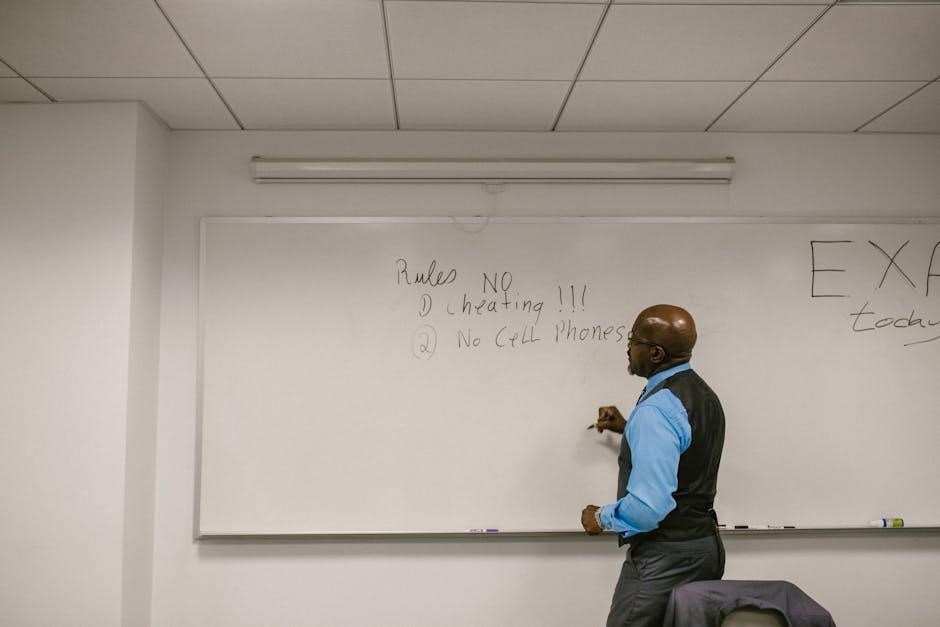Before commencing the test, familiarize yourself with the kit’s contents and the provided instructions. Ensure all components are present and unexpired. A preliminary review facilitates a smoother testing process, minimizing errors and ensuring reliable results. Understand each step before specimen collection.
Group A Streptococcus (Strep A) is a bacterium that can cause various infections, most commonly strep throat. Early and accurate detection is crucial to prevent complications like rheumatic fever and kidney inflammation. Strep A testing plays a vital role in diagnosing these infections, allowing for timely treatment with antibiotics.
Rapid Strep A tests are widely used due to their speed and ease of use. These tests detect the presence of Strep A antigens in throat swab samples. A positive result indicates a Strep A infection, while a negative result may require further confirmation with a throat culture, especially in children.
Understanding the principles behind Strep A testing is essential for healthcare professionals and individuals using at-home test kits. Proper specimen collection and adherence to test instructions are critical for accurate results. While at-home tests offer convenience, it’s important to confirm results with a healthcare provider, particularly for prescribing antibiotics.
Strep A testing contributes significantly to managing and controlling Strep A infections, reducing the risk of complications and promoting public health.

Kit Contents and Storage
A typical Strep A test kit usually contains several key components. These include test devices (cassettes or dipsticks), sterile swabs for specimen collection, reagent solutions (typically Reagent A and Reagent B), a positive control, a negative control, and detailed instructions for use. Some kits may also include workstations or test tubes.
Proper storage of the kit is crucial for maintaining its effectiveness. Kits should be stored at room temperature, typically between 36-86°F (2-30°C), and protected from direct sunlight and moisture. Ensure the kit is stored in its original packaging until use. Check the expiration date on the kit before use, and do not use expired kits as they may produce inaccurate results.
Inspect the kit contents upon receipt to ensure that all components are present and intact. If any components are missing or damaged, do not use the kit and contact the manufacturer or supplier for assistance. Keep the kit out of reach of children and pets.
Proper handling and storage of the Strep A test kit ensures reliable and accurate test results.
Specimen Collection Procedure
The accuracy of a Strep A test heavily relies on proper specimen collection. Use only the sterile swab provided in the kit. Instruct the patient to tilt their head back and open their mouth wide. Using a tongue depressor, gently hold down the tongue to improve visibility of the throat.
Swab the back of the throat, around the tonsils, and any areas exhibiting redness or pus. Avoid touching the cheeks, tongue, or teeth with the swab. Apply firm pressure and rotate the swab several times to ensure adequate sample collection. After swabbing, immediately insert the swab into the provided extraction tube.

If a bacterial culture is desired, gently streak the swab on a blood agar plate before using it in the Strep A test. This allows for further analysis if needed. Ensure that the swab is properly labeled with the patient’s information and the date of collection. Handle all specimens as if they contain infectious agents.
Proper specimen collection is paramount for accurate Strep A test results.
Reagent Preparation and Handling
Proper reagent preparation and handling are crucial for the accuracy and reliability of Strep A tests. Before commencing the test, carefully inspect all reagents included in the kit. Ensure that the reagents are within their expiration date and that there are no signs of contamination or damage.
Bring the reagents to room temperature before use, as specified in the kit instructions. This step ensures optimal reactivity and accurate test results. Some kits may require the addition of a specific volume of one reagent to another. Follow the instructions precisely, using the provided dropper or pipette to measure the correct amount.
Avoid interchanging caps between reagent bottles, as this can lead to cross-contamination and inaccurate results. Reagents A and B are slightly caustic, avoid contact with eyes, sensitive skin, and mucous membranes. In case of contact, immediately flush the affected area with plenty of water and seek medical attention.
Handle all reagents with care, wearing appropriate personal protective equipment, such as gloves and a lab coat. Dispose of used reagents according to local regulations.
Test Procedure: Step-by-Step Instructions
To ensure accurate results, follow the test procedure meticulously. First, gather all necessary materials, including the test device, reagents, sterile swab, and a timer. Ensure the test device is at room temperature. Label the device with the patient’s identification information.
Using the sterile swab provided, carefully collect a throat swab specimen. Swab both tonsils and the posterior pharynx, avoiding the tongue and cheeks. Place the swab into the extraction tube containing the appropriate reagent. Rotate the swab vigorously in the solution, ensuring thorough mixing.
Express the liquid from the swab by rolling it against the inside of the extraction tube and squeezing the tube as you remove the swab. Discard the swab appropriately. Dispense the extracted specimen into the designated area of the test device, following the kit’s instructions.
Set the timer and allow the test to develop for the specified time, typically 5-10 minutes. Read the results according to the kit instructions, noting the presence or absence of control and test lines.
Interpreting Test Results (Positive, Negative, Invalid)
Accurate interpretation of test results is paramount. A positive result typically shows both a control line and a test line, regardless of the test line’s intensity. This indicates the presence of Strep A antigen in the sample. A negative result shows a control line only, signifying the absence of detectable Strep A antigen.
An invalid result occurs when the control line is absent. This indicates a procedural error or deterioration of reagents. In such cases, repeat the test using a new test device and fresh reagents. Ensure all steps are followed correctly, and check the expiration dates of all components.
It’s crucial to document the test results accurately. Always correlate the test results with the patient’s clinical presentation. Remember that a negative rapid test doesn’t always rule out Strep A infection, and a throat culture may be necessary for confirmation, particularly in symptomatic individuals. Consult with a healthcare professional for proper diagnosis and treatment.
Quality Control Procedures
Adhering to rigorous quality control (QC) procedures is vital for ensuring the reliability and accuracy of Strep A test results. These procedures involve the use of both positive and negative controls to validate the test’s performance. Positive controls confirm the test’s ability to detect the presence of Strep A antigen, while negative controls verify the absence of cross-reactivity or false-positive results.
Run the controls according to the kit’s instructions, typically at the beginning of each new lot number, with each new shipment, and whenever there is a question about the test’s performance. Document the control results meticulously, and compare them to the expected outcomes. If the controls do not perform as expected, do not use the kit for patient testing until the issue is resolved.

Regularly inspect the test kits for any signs of damage or deterioration, such as discoloration or leakage. Ensure that the testing environment is within the recommended temperature range. Properly trained personnel should perform and interpret the tests to minimize human error.
Limitations of the Test
While Strep A rapid tests offer a convenient and quick method for detecting Group A Streptococcus, it’s crucial to acknowledge their limitations. These tests are designed for presumptive identification and should not be the sole basis for diagnosis or treatment decisions. A negative result does not definitively rule out a Strep A infection, especially if clinical suspicion is high. Factors such as improper specimen collection, low bacterial load, or the presence of interfering substances can lead to false-negative results.
False-positive results can also occur, although less frequently, due to cross-reactivity with other organisms or non-specific binding. The test’s sensitivity and specificity may vary depending on the specific kit and the patient population being tested. Results should always be interpreted in conjunction with the patient’s clinical presentation, medical history, and other relevant laboratory findings.

If the rapid test result is negative and clinical suspicion remains, consider performing a throat culture for definitive diagnosis.
Troubleshooting Common Issues
Encountering issues during Strep A testing can be frustrating, but many problems have straightforward solutions. If the control line does not appear, ensure the test device is not expired and that you followed the instructions precisely. Verify the correct amount of reagent was added and that the test was performed within the specified time frame. An absent control line renders the test invalid, requiring a repeat with a new device.
Weak or faint test lines can sometimes occur. Check the lighting conditions to ensure proper visualization. If the line remains faint, consider retesting with a new sample. If persistent faint lines occur, consult the kit’s manufacturer or your laboratory supervisor. Incorrect specimen collection is a common culprit. Ensure the swab makes good contact with the tonsils and posterior pharynx, avoiding the tongue or cheeks.
Review the instructions to confirm proper swabbing technique. Lastly, verify that reagents are not contaminated and were stored correctly.
Disposal of Used Materials
Proper disposal of used Strep A test kit materials is crucial for preventing the spread of infection and adhering to safety regulations. All components that come into contact with patient samples, including swabs, test devices, and used reagents, should be considered biohazardous waste. Place these items into designated biohazard waste containers lined with appropriate bags. These bags are typically red or orange and marked with the biohazard symbol.
Liquid waste, such as used reagents, should be carefully poured into a designated liquid biohazard waste container. Avoid splashes or spills during disposal. Solid waste, like the test cassettes and swabs, must be discarded into puncture-resistant containers to prevent accidental needle sticks or exposure to contaminated materials.
Always follow local, state, and federal regulations for biohazardous waste disposal. Typically, a certified waste disposal company will collect and properly dispose of the biohazard waste. Never dispose of these materials in regular trash receptacles. After disposing of the materials, thoroughly wash your hands with soap and water.
